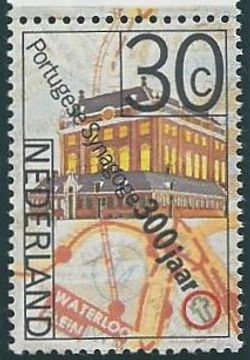top of page
western europe
Jews who had hidden their religion in Spain and Portugal (crypto-Jews) moved to western European countries in the 1600s.
Secret Jews ('Marranos') came from Spain to Amsterdam in 1593, where they found a much more religiously tolerant atmosphere. They brought important skills in commerce, navigation, and medicine. Although Jews had been expelled from England in 1290, a group of Marranos was allowed to form a congregation in 1656 and were active businessmen. More Sepharadim arrived, and the Spanish Portuguese Bevis Marks synagogue was built in 1701. These Protestant countries proved more hospitable to Jews than Catholic Spain and Portugal.
 West Europe.Amsterdam.synagogueThe Inquisition in Spain and Portugal continued for centuries. Jews who had converted migrated from Portugal to the Netherlands, where they prospered. This synagogue was completed in 1675 and stands on wooden poles over a canal. Its floor is covered in sand, for quiet and cleanliness. It is called 'Esnoga' in Ladino. This synagogue, with its high walls and hanging candelabra became the model for many later Sephardic synagogues in the West. The postcard actually pictures a scale model. |  West Europe.Amsterdam.syn.stampThe Portuguese synagogue of Amsterdam was honored on a Netherlands postage stamp in 1975. This brown brick building seats 2000 and is lit by 72 windows. 613 tapers provide interior lighting. Vandalized in WWII, the building was restored in the 1950s and 60s. Officiants still wear traditional dark clothes, tall hats, and white bib collars. |  West Europe.Amsterdam.stampIsrael also honored this synagogue on a stamp, in 1970. It was part of a 5 stamp series of landmark synagogues around the world. Here it is shown on a photo postcard of the synagogue as it looked in 1970. Today it functions mostly as an historical sight. |
|---|---|---|
 West Europe.Amsterdam.Sn interiorThis painting from 1923 gives a sense of some of the grandeur of this famous synagogue. |  West Europe.Amsterdam.CalendarThis Jewish calendar ('Luach') was published in Amsterdam in the Jewish year 5529 = 1769. But it is not an annual calendar. Rather it is a set of tables that explains how to calculate every year's main dates, in both regular and Leap years, for the coming 112 years! |  West Europe.Calendar.tablesThe directions explain how to identify 'types' of years and thus to know when holidays will fall out. Text is in Hebrew and Portuguese. |
 West Europe.calendar.directionsReading from the back, explanations are given in Hebrew and in Portuguese, with examples of how to use the tables to calculate each year's important dates. There is also a list in Hebrew of what Torah readings go with each holiday. |  West.Europe.Amsterdam.MachzorThis machzor, holiday prayer book, for Rosh Hashana, was published in Amsterdam in 1771. Its compiler is listed on the front page as Shmuel Rodriguez Mendes. The publisher, a relative, is Yaakov da Silo Mendes. The text and directions are all in Hebrew. |  West Europe.England.medalJews had been expelled from England in 1290. They were informally tolerated in 1656 and the Jewish community developed from then. This medal by Vincze was issued in 1956 to commemorate the 300th anniversary of the re-establishment of the English Jewish community. |
 West Europe.England.medal.revMenasseh ben Israel was born to Portuguese refugees & grew up in Amsterdam. A rabbi & diplomat, he established the first Hebrew printing press there in 1626. Filled with Messianic hopes, he was instrumental in persuading Oliver Cromwell, Lord protector of the British commonwealth (ruler), to permit Jews to openly settle in England. This side of the medal honors both men. |  England.Bevis Marks syn.oldServices are mentioned already in the 1660s. The community built this synagogue in 1701. It is the oldest, most beautiful, and longest in continuous use in Great Britain. This card reproduces an aquatint from the 19th century. |  England.Bevis Marks synThe synagogue was patterned after the great Spanish and Portuguese synagogue in Amsterdam. In fact, that community donated the central chandelier of this building. |
 England.Syn Bevis Marks.exteriorThis is the courtyard in front of the synagogue. The official name is 'Qahal Kadosh Sha'ar Hashamayim. |  Western Europe.England.MontefioriSir Moses Montefiori was born to English parents from an old Italian Sephardic family. He obtained a coveted stockbroker license at age 20 and became quite wealthy. By 40 he was devoting his time to Jewish philanthropic and humanitarian causes around the world, especially in the Holy Land where he supported communities. This letter was written from his summer estate in Ramsgate in 1885 regarding funds sent to the Holy Land. |  West Europe.England.Montefiori medalThis medalet was struck to honor Montefiori for his support of Jewish communities in the Holy Land. "A remembrance of his largesse among Israel and his support for Lovers of Jerusalem". The reverse honors Edmund Rothschild for his support of the Holy Land. |
 West Europe.Bevis marks.cover |  England.Spanish Portuguese SynagogueStationery from the Synagogue. |  Orphans_SocietyA society for the support of orphans from the Spanish & Portuguese community was instituted in 1703. This book lists the society's revised provisions, published in 1885. The purpose: maintain, clothe, educate, and apprentice orphan boys of the S & P Jews' Congregation. |
 England.Sp Portuguese .PrayerThe community circulated this prayer sheet soon after World War II began. |  Spanish Portuguese Prayer TextThe Hebrew is more detailed than the English: "Sit on the seat of mercy...Hear the groans of our children...help our defenders overcome their enemies...destroy those rising against us...Give us salvation soon". |  WOS.Britain.orphan society laws 001 (2) |
bottom of page